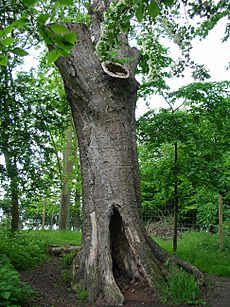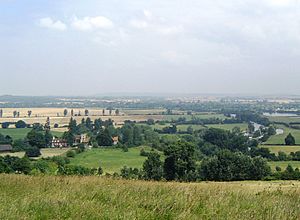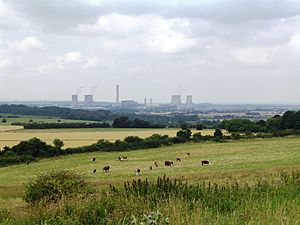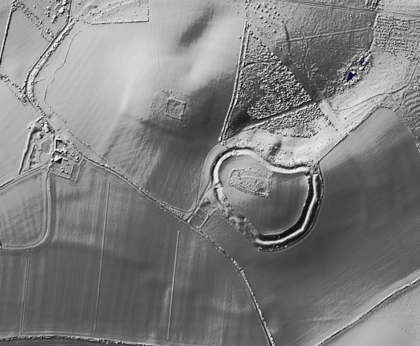Wittenham Clumps facts for kids
Wittenham Clumps are two hills covered in trees in the Thames Valley area of England. They are located in a place called Little Wittenham, which is part of South Oxfordshire.
The taller hill is called Round Hill, and it's about 119 meters (390 feet) above sea level. The other hill, Castle Hill, is about 107 meters (350 feet) tall and is located about 350 meters (380 yards) to the southeast. Castle Hill was once home to an Iron Age hill fort. There's also a third hill nearby called Brightwell Barrow, but it's not usually considered part of the Clumps.
The grassy sides of the Clumps lead up to the tops, which are covered in some of the oldest beech trees planted in England. These trees were first planted way back in the 1740s! The Clumps stand over 70 meters (230 feet) higher than the land around them, so they are easy to spot and offer amazing views. From the top, you can see villages and towns that were some of the first places settled by the English. The famous artist Paul Nash saw the view in 1911 and called it "a beautiful legendary country haunted by old gods long forgotten."
Wittenham Clumps is the most visited outdoor spot in Oxfordshire, with more than 200,000 people visiting each year. A car park was built in 1971, and there are many paths that you can walk on all year round. A path through the wooded area at the top of Round Hill reopened in 2005 after being closed for twenty years. The whole area is looked after as a Nature Reserve by an organization called the Earth Trust.
What's in a Name?
The name "Wittenham Clumps" usually refers to the wooded tops of these hills. The hills themselves are actually called the Sinodun Hills. The name Sinodun comes from an old Celtic word, "Seno-Dunum," which means 'Old Fort'.
Another, less common, nickname for the Clumps is Berkshire Bubs. This name comes from the fact that the Clumps are in the historic county of Berkshire, even though the area became part of Oxfordshire in 1974.
On Sinodun Hill, there's a hollow called the Money-Pit. People used to believe a treasure was hidden there, guarded by a raven! There's also a group of trees called the Cuckoo Pen. Local stories say that if you could trap a cuckoo there, it would make Summer last forever.
Where are the Clumps?
Wittenham Clumps are located near the River Thames. You can get great views of the Clumps from the Thames Path along the river. The views from the Clumps themselves are also amazing, showing off the countryside of Berkshire and Oxfordshire.
On the north side of Round Hill, there's a guide that points out many sights you can see. The furthest is Faringdon Folly, a tower built on another Iron Age hillfort about 27 kilometers (17 miles) to the west. You can clearly see Day's Lock and Dorchester Abbey in the valley to the north. The tall Plowman Tower in Northway, Oxford, which is 15 stories high, can be seen about 14 kilometers (9 miles) away.
To the north-west, you might spot the white buildings of the Joint European Torus. This is where the world's first successful controlled nuclear fusion experiments happened, about 6 kilometers (4 miles) away. To the west, you can see the town of Didcot, with some of the chimneys from the gas-fired Didcot B Power Station. In the past, very tall cooling towers from Didcot A Power Station used to dominate the skyline, but they were taken down between 2014 and 2020.
To the north-east is Little Wittenham Wood, which is next to the Thames. To the south-east is Brightwell Barrow.
Please note that the wooded area at the top of Castle Hill is currently closed because of the danger of falling trees. The entrance to the wooded area on Round Hill also has a warning about falling branches due to a fungus affecting many of its trees.
Discovering the Past
There is an old hillfort on Castle Hill. The earliest earthworks, which are changes made to the land, date back to the late Bronze Age. More banks and ditches were added during the early Iron Age.
Archaeologists have dug up parts of the hillfort. They found that the people living there during the Iron Age caught fish and wild boar. They also raised cattle and sheep. There is also proof that they grew barley and wheat. It seems the fort was left empty by the late Iron Age. The next people to live there were the Romans.
In 2004, a TV show called Time Team focused on the Clumps. They investigated the area around Castle Hill to find out more about its history. Over three days, Time Team used special radar to look underground. They found many hidden features, like ditches, pits, and possible buildings. They even found a large rectangular area that they decided to dig up. This dig uncovered the remains of a Roman-British house on the southern slope of Round Hill. It had tesserae (mosaic) floors and painted walls! They also found an Iron Age cobbled floor and holes where wooden posts might have stood.
Further digs found Iron Age rubbish pits all over the valley. This suggests that many people lived in the area during that time. Pottery found showed that most activity happened in the early and late parts of the Iron Age. The radar surveys also found more suspected Iron Age enclosures and what looked like a Roman road.
Overall, the discoveries suggest that people have lived in this area since the Bronze Age, around 1000 BC. The hillfort and farms around it date from about 600 BC. Later, people moved down towards the southern part of the site around 300 BC. The area was then abandoned until the Roman villa was built.
Many old objects have been found here. These include an oval bronze shield, about 35 cm (14 inches) across, found in the nearby river Isis in 1836. A 70 cm (28 inch) long sword and its scabbard (sheath) were found in 1982. This sword dates from the Late Iron Age (120 BC - AD 43).
In 2021, archaeologists found at least 15 roundhouses from 400 to 100 BC. They also found parts of a Roman villa from the 3rd to early 4th century CE. Experts believe a noble family might have lived in this Roman villa. Researchers also found Roman kitchen tools and an Iron Age "fridge" or pantry. These were ceramic containers used to keep food cool in a pit dug into the ground.
The Poem Tree

On the eastern side of Castle Hill, there used to be a famous beech tree called the 'Poem Tree'. In 1844–45, a man named Joseph Tubb carved a poem into it. The tree sadly died in the 1990s and fell down in 2012. Now, there is a stone that remembers the 150th anniversary of the poem being carved.
It is also said that the writer Matthew Prior wrote his poem Henry and Emma at Wittenham Clumps. A special plaque remembers this.
Clumps in Media
Wittenham Clumps has been featured in different types of media:
- The 20th-century British artist Paul Nash painted Wittenham Clumps many times.
- The band Radiohead filmed a webcast video for their song "Faust Arp" at the Clumps.
- The ending of an episode from the Netflix series Black Mirror, called "Shut Up and Dance", takes place in the woods at the Clumps.




